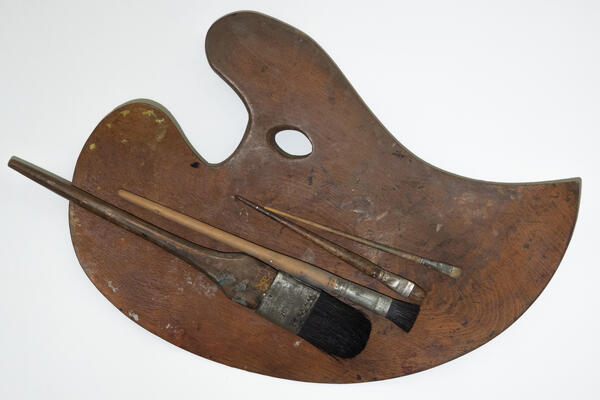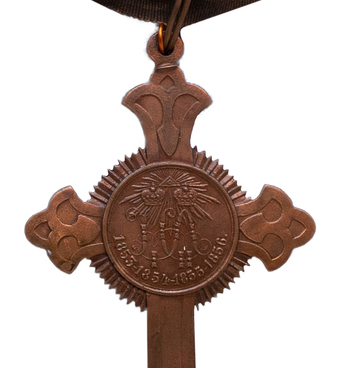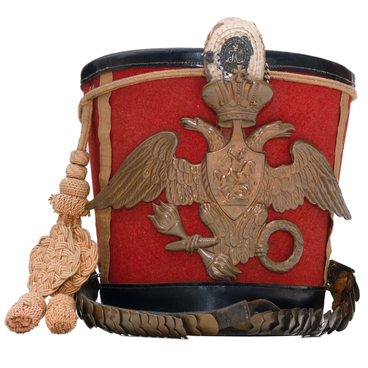Four paintbrushes of the Soviet painter and graphic artist Pavel Sokolov-Skalya were donated to the museum by his wife Anastasia Sokolova-Skalya in 1962. In the exhibition, they are presented together with a palette.
The large flat brush is 60 centimeters long. Its black bristles are connected to a wooden handle with an iron plate. The middle brush and the other two smaller ones are round.
Pavel Sokolov-Skalya was born on July 3, 1899, in the village of Strelna, Leningrad Region. Today, it is on the southern coast of the Gulf of Finland in St. Petersburg. In 1914–1918, Sokolov-Skalya studied drawing in the Moscow studio of Ilya Mashkov — one of the founders of the art association “Jack of Diamonds”.
During the Civil War, the artist lived with his uncle in Khvalynsk (a city in the Saratov region), and in 1920 he returned to Moscow. Then he became a co-founder and chairperson of the Bytiye artist association, and from 1920 to 1922 he studied at the Higher State Artistic and Technical Workshops (VKHUTEMAS).
In 1926, Sokolov-Skalya became a member of the Academy of Arts, the Association of Artists of Revolutionary Russia. In the late 1920s — 1930s, the artist took part in a major Soviet art propaganda project. During this period, he created a whole series of well-known propaganda posters: in 1928, he painted “Long live May 1”, in 1929 — “Stop. The last warning”, in 1939 — “The train goes from Socialism station to Communism station”.
In 1933–1941, Sokolov-Skalya taught at the Grekov Studio of War Artists. During the Great Patriotic War, he became the artistic director of “TASS Windows” and created over 300 posters. In the postwar years, the artist returned to teaching again — this time at the Vasily Surikov Moscow Art Institute.
Sokolov-Skalya was not only a poster artist but also an illustrator, theater artist, master of panoramas and dioramas. In 1937, the artist worked on the panorama “Siege of Perekop”, which included “The First Cavalry Army in Wrangel’s Rear”, one of his four dioramas.
In 1953–1954, after the death of the People’s Artist of the RSFSR Vasily Yakovlev, Sokolov-Skalya supervised the reconstruction of Franz Roubaud’s panorama “The Siege of Sevastopol 1854–1855”. It suffered from the bombing during the Great Patriotic War. Sokolov-Skalya added his own scenes like “N. I. Pirogov comes to the dressing station”, “Return of the sailors Pyotr Koshka and Fyodor Zaika to the bastion” and others. In 1954, the panorama was opened again on the 100th anniversary of the first heroic defense of the city.
The large flat brush is 60 centimeters long. Its black bristles are connected to a wooden handle with an iron plate. The middle brush and the other two smaller ones are round.
Pavel Sokolov-Skalya was born on July 3, 1899, in the village of Strelna, Leningrad Region. Today, it is on the southern coast of the Gulf of Finland in St. Petersburg. In 1914–1918, Sokolov-Skalya studied drawing in the Moscow studio of Ilya Mashkov — one of the founders of the art association “Jack of Diamonds”.
During the Civil War, the artist lived with his uncle in Khvalynsk (a city in the Saratov region), and in 1920 he returned to Moscow. Then he became a co-founder and chairperson of the Bytiye artist association, and from 1920 to 1922 he studied at the Higher State Artistic and Technical Workshops (VKHUTEMAS).
In 1926, Sokolov-Skalya became a member of the Academy of Arts, the Association of Artists of Revolutionary Russia. In the late 1920s — 1930s, the artist took part in a major Soviet art propaganda project. During this period, he created a whole series of well-known propaganda posters: in 1928, he painted “Long live May 1”, in 1929 — “Stop. The last warning”, in 1939 — “The train goes from Socialism station to Communism station”.
In 1933–1941, Sokolov-Skalya taught at the Grekov Studio of War Artists. During the Great Patriotic War, he became the artistic director of “TASS Windows” and created over 300 posters. In the postwar years, the artist returned to teaching again — this time at the Vasily Surikov Moscow Art Institute.
Sokolov-Skalya was not only a poster artist but also an illustrator, theater artist, master of panoramas and dioramas. In 1937, the artist worked on the panorama “Siege of Perekop”, which included “The First Cavalry Army in Wrangel’s Rear”, one of his four dioramas.
In 1953–1954, after the death of the People’s Artist of the RSFSR Vasily Yakovlev, Sokolov-Skalya supervised the reconstruction of Franz Roubaud’s panorama “The Siege of Sevastopol 1854–1855”. It suffered from the bombing during the Great Patriotic War. Sokolov-Skalya added his own scenes like “N. I. Pirogov comes to the dressing station”, “Return of the sailors Pyotr Koshka and Fyodor Zaika to the bastion” and others. In 1954, the panorama was opened again on the 100th anniversary of the first heroic defense of the city.



